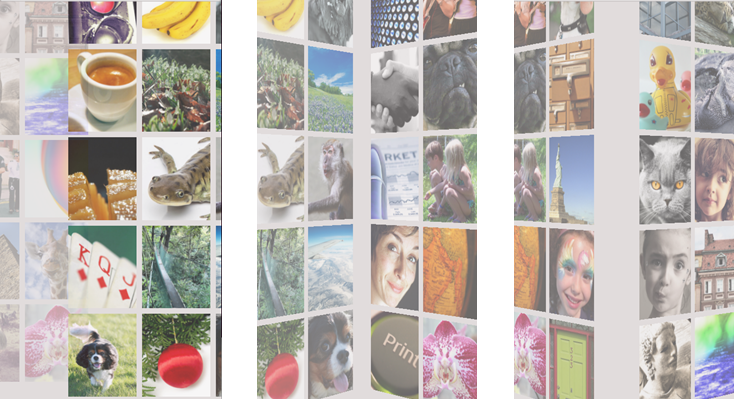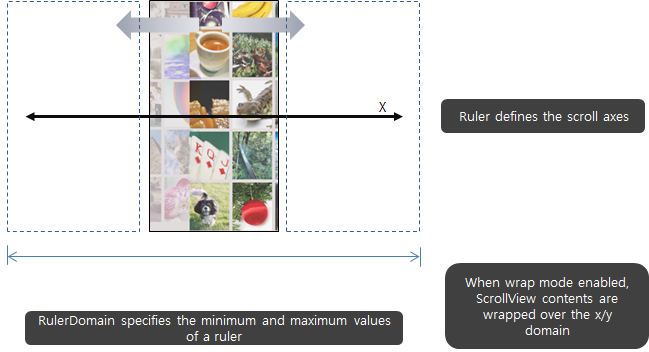ScrollView: Scrollable Container for Items
The Dali::Toolkit::ScrollView class provides a scrollable view, which contains actors and can be scrolled automatically or manually by panning.
The following figure shows example layouts using the ScrollView.
Figure: ScrollView

A scroll view emits a ScrollView::SnapStartedSignal() signal when the scroll view has started to snap or flick. The signal informs the target of the scroll position, scale, and rotation.
Creating a ScrollView
The following example shows how to create a Dali::Toolkit::ScrollView object:
// This sample code is for the HelloWorldExample class // in Creating a DALi Application void HelloWorldExample::Create( Application& application ) { // Create a ScrollView instance ScrollView scrollView = ScrollView::New(); scrollView.SetParentOrigin( ParentOrigin::CENTER ); Stage::GetCurrent().Add( scrollView ); // Set the size of scrollView; it covers the entire stage Size size = Stage::GetCurrent().GetSize(); scrollView.SetSize( size ); // Add actors to the ScrollView for( int i; i < MY_ITEM_COUNT; ++i ) { ImageView imageView = ImageView::New( MY_IMAGE_PATHS[i] ); imageView.SetAnchorPoint( AnchorPoint::TOP_LEFT ); imageView.SetPosition( i * size.x, 0.0f ); scrollView.Add( imageView ); } // ScrollView contents are now draggable // To enforce horizontal-only scrolling, the Y axis ruler can be disabled RulerPtr rulerY = new DefaultRuler(); rulerY->Disable(); scrollView.SetRulerY( rulerY ); // To enable snapping, a FixedRuler can be applied to the X axis, // with snap points spaced to the width of the stage RulerPtr rulerX1 = new FixedRuler( size.width ); scrollView.SetRulerX( rulerX1 ); // Domain can be applied to rulers to prevent scrolling beyond this boundary // In this case, to 4 times the width of the stage, allowing for 4 pages to be scrolled RulerPtr rulerX2 = new FixedRuler( size.width ); rulerX2->SetDomain( RulerDomain( 0.0f, size.width*4.0f ) ); scrollView.SetRulerX( rulerX2 ); }
Using Ruler, RulerDomain, and Wrap
The Dali::Toolkit::Ruler abstract class defines the scroll axes. The Dali::Toolkit::RulerDomain class specifies the minimum and maximum values of a ruler.
The Dali::Toolkit::ScrollView class provides a wrap mode for ScrollView contents. When enabled, the ScrollView contents are wrapped over the x/y domain.
The ScrollView behavior depends on a combination of the ruler, ruler domain, and wrap modes. The following table shows ScrollView behavior according to the combination.
Figure: Ruler, ruler domain, and wrap modes

| Ruler | Domain | Wrap | Behavior |
|---|---|---|---|
| Disabled | Disabled | Wrap | No movement in axis |
| Disabled | Enabled | No wrap | No movement in axis |
| Disabled | Enabled | Wrap | No movement in axis |
| Enabled | Disabled | No wrap | Free movement in axis |
| Enabled | Disabled | Wrap | Free movement in axis, wrapped according to domain minimum and maximum |
| Enabled | Enabled | No wrap | Movement limited to domain minimum and maximum |
| Enabled | Enabled | Wrap | Movement limited to domain minimum and maximum |
| Note |
|---|
| Actors within a ScrollView are controlled by constraints. If you apply constraints to these actors externally, undefined behavior can occur. Since applying additional constraints can conflict with the ScrollView constraints, place the actors within container actors. The container actors are affected by the constraints. |


